
Waterproofing Failures on Recreation Decks and Plaza Areas
By Scott Harvey-Lewis / Published Nov 2015
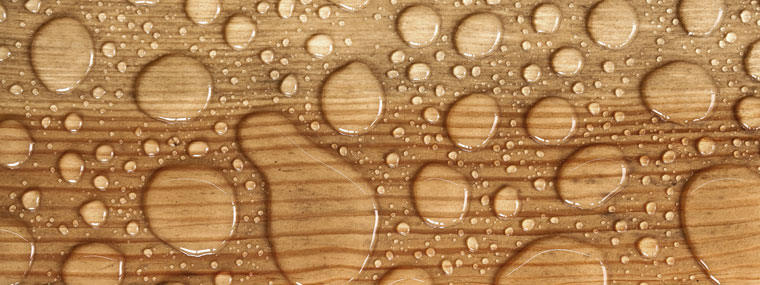
A common trend has been noticed in condominium investigations throughout Florida. Whether a 40 year recertification, reserve study analysis, or a condition assessment for property turnover, one of the most common and detrimental defects observed has been the failure of waterproofing systems on recreation decks or plaza areas. These failures are of a serious nature and, if left untreated, can ultimately result in the deterioration of reinforced concrete. This danger is compounded when these areas are located directly above residential units, commercial spaces, or other common interior spaces. This issue is not always visible to the naked eye, which means that damage could have been occurring for some time before being noticed. When the problem is hidden, invasive inspections—where finishes are professionally removed to locate and repair or replace the problem—may be required. Due to potential water infiltration into interior spaces, these issues, when brought to one’s attention, should be addressed with urgency.
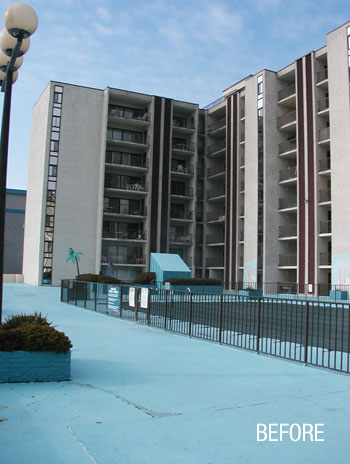 Some key factors that contribute to the failure of waterproofing systems include improper installation, end of material useful life, design defects, or a combination of these deficiencies. In order to meet the Florida Building Code (FBC) requirements for weather protection,
Some key factors that contribute to the failure of waterproofing systems include improper installation, end of material useful life, design defects, or a combination of these deficiencies. In order to meet the Florida Building Code (FBC) requirements for weather protection,
a waterproofing system must be designed and installed in accordance with an approved manufacturer’s instructions. The performance of an installed waterproofing system is highly dependent on this requirement, so much so, that manufacturers will void system warranties if improper design and installation are proven. Furthermore, the FBC and other industry design standards enforce minimum requirements for the slope, slab reinforcement, and construction methods of the structural deck to support the performance of waterproofing system. When this criteria is not met, standing water, cracking in the structural slab, and other design defects promote premature failure of the waterproofing system. On the other hand, even a properly designed and installed system has an estimated useful life, and due to age can become brittle and crack resulting in system failures.
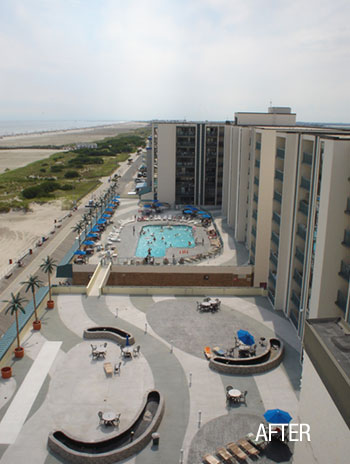 Whatever the reason, failures are usually discovered when water damage or suspect microbial growth (mold/mildew) is visually observed on interior finishes. Simple, interior renovations can address this damage; however, corrective measures must be taken to address the system failure, as the waterproofing system not only provides weather protection to interior finishes, but also protects the supporting structural components of the deck itself. Therefore, failures if left unresolved, over time, can compromise the structural integrity of the deck.
Whatever the reason, failures are usually discovered when water damage or suspect microbial growth (mold/mildew) is visually observed on interior finishes. Simple, interior renovations can address this damage; however, corrective measures must be taken to address the system failure, as the waterproofing system not only provides weather protection to interior finishes, but also protects the supporting structural components of the deck itself. Therefore, failures if left unresolved, over time, can compromise the structural integrity of the deck.
Unfortunately, as with many repair projects, a “band-aid” solution is usually implemented. Visible damages are repaired without an investigation into the actual cause and origin of the system failure. By neglecting the cause, system failures continue to occur resulting in future damage and accelerated deterioration of building elements. This is why it is always recommended that registered design professional (registered architect (RA) or a licensed engineer (PE)) investigate waterproofing failures. The design professional has the responsibility to specify the most appropriate repair approach for the client, both in terms of efficacy and budgetary constraints.
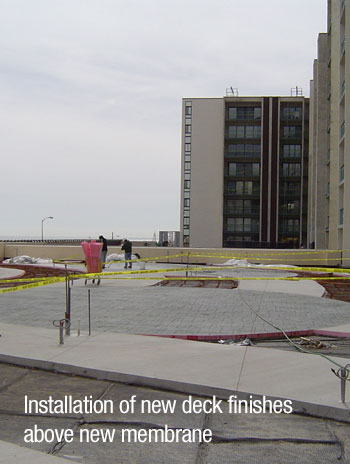 If the failures are a result of age or systemic installation defects (a defect throughout the waterproofing system), the recommended fix for the association often ends up being the removal and reinstallation of the entire waterproofing system. This is why it is strongly encouraged that associations are familiar with the age, type, and condition of the waterproofing system applied to their recreation decks. Having this knowledge will enable the association to better prepare for such a project, instead of being forced into this major renovation because of failures causing ongoing damage.
If the failures are a result of age or systemic installation defects (a defect throughout the waterproofing system), the recommended fix for the association often ends up being the removal and reinstallation of the entire waterproofing system. This is why it is strongly encouraged that associations are familiar with the age, type, and condition of the waterproofing system applied to their recreation decks. Having this knowledge will enable the association to better prepare for such a project, instead of being forced into this major renovation because of failures causing ongoing damage.
The good news is that in an ever-evolving construction industry, mistakes of the past have been instrumental in the development of new products and techniques that better meet the challenges associated with waterproofing these specific areas. For instance, items commonly “value engineered” out of the construction project in the past, such as a drainage mat, are now deemed essential to the proper function of the waterproofing system.
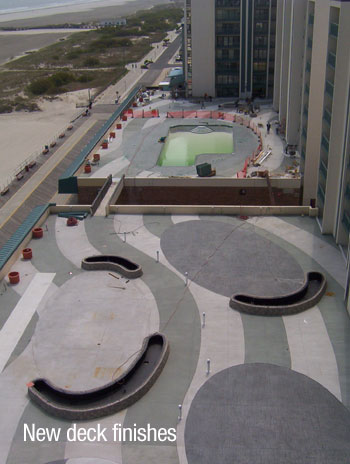 Ocean Front Condominium consists of two, 11-story towers with an adjoining 42,500 sf recreation deck that also serves as a roof to commercial spaces, office spaces, and garage parking below. The recreation deck includes a large swimming pool, Jacuzzi, and generous seating area. The Falcon Group was tasked with diagnosing the source of waterproofing failures along the recreation deck, which resulted in water damage to interior finishes as well as structural damage to the concrete deck below the plaza and specifying restoration design to the damaged areas. The existing waterproofing system consisted of a 40-year-old bitumen membrane below a failing concrete hardscape. The system had become brittle due to age. Poor workmanship, construction defects, and inadequate flashing details became especially apparent as the materials had lost their flexibility. The association had spent tens of thousands of dollars each year patching spalling surface concrete, installing interior gutters, applying unattractive surface coatings, and replacing caulk in the attempt to stop water migration.
Ocean Front Condominium consists of two, 11-story towers with an adjoining 42,500 sf recreation deck that also serves as a roof to commercial spaces, office spaces, and garage parking below. The recreation deck includes a large swimming pool, Jacuzzi, and generous seating area. The Falcon Group was tasked with diagnosing the source of waterproofing failures along the recreation deck, which resulted in water damage to interior finishes as well as structural damage to the concrete deck below the plaza and specifying restoration design to the damaged areas. The existing waterproofing system consisted of a 40-year-old bitumen membrane below a failing concrete hardscape. The system had become brittle due to age. Poor workmanship, construction defects, and inadequate flashing details became especially apparent as the materials had lost their flexibility. The association had spent tens of thousands of dollars each year patching spalling surface concrete, installing interior gutters, applying unattractive surface coatings, and replacing caulk in the attempt to stop water migration.
The work was required to be completed in phases to limit disturbance to commercial tenants below and residential tenants and renters above the deck. Material selection for waterproofing had constraints of selecting a system that could be applied on: a minimum slope, structural concrete that had not fully cured, and on work areas that were slightly wet (as a result of the tight construction schedule and regular afternoon rain events).
Scott Harvey Lewis
PE, LEED AP,The Falcon Group
Scott Harvey-Lewis, PE, LEED AP is with The Falcon Group, Miami/West Palm Beach, FL. Harvey-Lewis is a Senior Engineer, responsible for structural and forensic engineering, and building envelope investigations in the firm’s Engineering Division. He has more than a decade of experience providing structural engineering design, construction administration and forensic services to public-and private-sector clients on a wide range of projects. As a forensic engineer, Harvey-Lewis investigates structural failures, water intrusion, building construction alleged defects and code compliance on behalf of attorneys, owners, developers, and insurance companies, among others. For more information, visit www.falconengineering.com.
The failing system was replaced with an FBC approved, waterproofing membrane with low odor. A drainage mat was installed over the membrane to facilitate drainage and a new patterned concrete surface was installed over the system, along with planters, seating areas, and other hardscape features around the pool. The result is a watertight, restored structure, with architectural and landscape upgrades, which add curb appeal and value to the community. Due to the successful design and installation of the new system, the manufacturer issued a 25-year warranty to the association for the product.
Failing waterproofing on recreation decks can cause distress to an association. The first step in addressing these failures is to have a licensed design professional identify via investigation the cause of failure and what repair options exist. If a full system replacement is warranted, the re-waterproofing of the recreation deck can be successful by specifying an FBC approved system, and ensuring that the installation is performed in strict accordance with manufacturer’s instructions.


